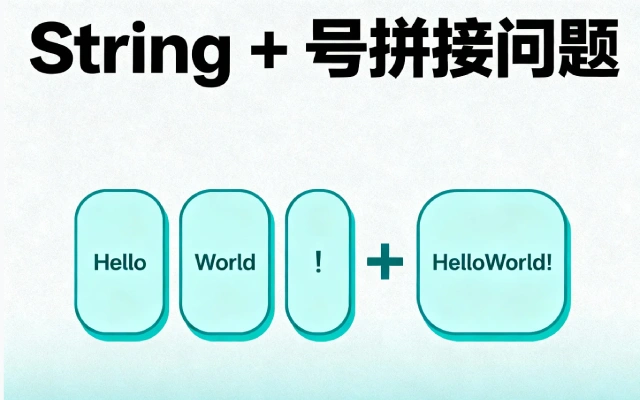提高Java代码性能的17个奇技淫巧,让你的程序飞起来!
Java 编码优化是一个持续的过程,涉及到多个方面,包括代码的可读性、性能以及资源利用。以下提供了一些常见的 Java 编码优化技巧,同时附带业务场景案例和代码示例,帮助您更好地理解。

1. 避免不必要的对象创建
业务场景:在处理大量数据的业务场景中,频繁创建对象会增加垃圾收集的负担。
优化前:
public void processLargeCollection(List<String> list) {
for (String str : list) {
String trimmedStr = str.trim();
// 处理逻辑
}
}
优化后:
public void processLargeCollection(List<String> list) {
for (String str : list) {
// 直接在循环中处理字符串,避免创建新对象
if (str.startsWith("prefix")) {
// 处理逻辑
}
}
}
2. 使用合适的数据结构
业务场景:在需要频繁查找、添加、删除操作的场景中,选择合适的数据结构可以提高效率。
优化前:
List<String> list = new ArrayList<>(); // 频繁进行查找操作,效率低
优化后:
Set<String> set = new HashSet<>(); // 使用 HashSet 进行查找,效率更高
3. 缓存结果
业务场景:对于重复计算且计算成本高的逻辑,可以使用缓存来存储结果。
优化前:
public int getFibonacci(int n) {
if (n <= 1) {
return n;
}
return getFibonacci(n - 1) + getFibonacci(n - 2);
}
优化后:
public int getFibonacci(int n, Map<Integer, Integer> cache) {
if (n <= 1) {
return n;
}
if (cache.containsKey(n)) {
return cache.get(n);
}
int result = getFibonacci(n - 1, cache) + getFibonacci(n - 2, cache);
cache.put(n, result);
return result;
}
4. 避免使用全局变量
业务场景:全局变量可能导致不必要的内存占用,并在多线程环境中引发同步问题。
优化前:
public class AppConfig {
public static String configValue = "default";
// ...
}
优化后:
public class AppConfig {
private String configValue = "default";
public String getConfigValue() {
return configValue;
}
// ...
}
5. 使用局部变量
业务场景:局部变量的生命周期更短,可以减少内存占用。
优化前:
public class Service {
public static int staticVar = 0;
// ...
}
优化后:
public class Service {
public int localVar = 0;
// ...
}
6. 避免使用过宽的访问权限
业务场景:限制变量或方法的访问权限可以减少不必要的外部访问。
优化前:
public class User {
public String name;
// ...
}
优化后:
public class User {
private String name;
public String getName() {
return name;
}
// ...
}
7. 使用 StringBuilder/Buffer
业务场景:在字符串拼接频繁的场景中,使用 StringBuilder 可以提高性能。
优化前:
String result = "";
for (String str : list) {
result += str;
}
优化后:
StringBuilder sb = new StringBuilder();
for (String str : list) {
sb.append(str);
}
String result = sb.toString();
8. 避免使用 finalize 方法
业务场景:finalize 方法的执行时机不确定,可能导致资源释放不及时。
优化前:
public class Resource {
@Override
protected void finalize() throws Throwable {
super.finalize();
// 释放资源
}
}
优化后:
public class Resource implements AutoCloseable {
public void close() {
// 释放资源
}
// ...
}
9. 并发优化
业务场景:在需要处理大量并发请求的场景中,合理使用线程池可以提高系统响应速度。
优化前:
ExecutorService service = Executors.newCachedThreadPool(); service.execute(runnable);
优化后:
ExecutorService service = Executors.newFixedThreadPool(10); service.submit(runnable);
10. 避免使用同步代码块
业务场景:在高并发场景中,过度同步会降低性能。
优化前:
synchronized (this) {
// 执行操作
}
优化后:
Lock lock = new ReentrantLock();
lock.lock();
try {
// 执行操作
} finally {
lock.unlock();
}
11. 利用现代 Java 的 Stream API
业务场景:处理集合数据时,Stream API 可以提供更简洁、更高效的代码。
优化前:
List<String> results = new ArrayList<>();
for (String str : list) {
if (str.startsWith("prefix")) {
results.add(str);
}
}
优化后:
List<String> results = list.stream()
.filter(str -> str.startsWith("prefix"))
.collect(Collectors.toList());
12. 减少不必要的类型转换
业务场景:频繁的类型转换会影响性能,特别是涉及到基础数据类型和包装类之间的转换。
优化前:
Integer integerValue = 100; int intValue = integerValue; // 自动拆箱
优化后:
int intValue = 100; // 使用原始类型
13. 使用更精确的数据类型
业务场景:根据实际需要选择最合适的数据类型,避免使用过大的数据类型。
优化前:
Integer count = 0;
for (...) {
count++; // 使用 Integer 可能导致不必要的自动装箱
}
优化后:
int count = 0; // 使用更精确的原始类型
for (...) {
count++;
}
14. 避免使用过于复杂的正则表达式
业务场景:正则表达式是强大的字符串处理工具,但过于复杂的正则表达式会严重影响性能。
优化前:
Pattern pattern = Pattern.compile(".*some complex pattern.*");
Matcher matcher = pattern.matcher(inputString);
boolean found = matcher.find();
优化后:
Pattern pattern = Pattern.compile("some simpler pattern");
// ...
15. 避免在循环中使用 I/O 操作
业务场景:I/O 操作通常是非常耗时的,应该避免在循环中进行。
优化前:
for (int i = 0; i < 1000; i++) {
writeToFile(data);
}
优化后:
List<String> dataBatch = new ArrayList<>();
for (int i = 0; i < 1000; i++) {
dataBatch.add(data);
}
writeToFile(dataBatch); // 一次性写入多个数据
16. 利用懒加载
业务场景:懒加载可以延迟对象的创建,直到真正需要它们的时候。
优化前:
class MyService {
private ExpensiveResource resource = new ExpensiveResource();
}
优化后:
class MyService {
private ExpensiveResource resource;
public synchronized ExpensiveResource getResource() {
if (resource == null) {
resource = new ExpensiveResource();
}
return resource;
}
}
17. 避免过早优化
业务场景:过早优化可能会让代码变得复杂且难以维护。
优化建议:
- 首先关注代码的清晰性和正确性。
- 使用性能分析工具确定性能瓶颈。
- 根据性能分析的结果有针对性地进行优化。
结语
优化技巧的选择和应用需要根据具体的业务场景和性能瓶颈来决定。在进行优化时,应该首先识别瓶颈所在,然后有针对性地应用优化策略。同时,优化也应该以不牺牲代码的可读性和可维护性为前提。在某些情况下,过度优化可能会使代码变得复杂而难以维护。因此,优化应该是一个权衡的过程,需要根据实际情况进行选择。此外,利用现代 Java 语言的特性和库,如 Stream API、Lambda 表达式等,可以编写出更简洁、更高效的代码。
以上关于提高Java代码性能的17个奇技淫巧,让你的程序飞起来!的文章就介绍到这了,更多相关内容请搜索码云笔记以前的文章或继续浏览下面的相关文章,希望大家以后多多支持码云笔记。
如若内容造成侵权/违法违规/事实不符,请将相关资料发送至 admin@mybj123.com 进行投诉反馈,一经查实,立即处理!
重要:如软件存在付费、会员、充值等,均属软件开发者或所属公司行为,与本站无关,网友需自行判断
码云笔记 » 提高Java代码性能的17个奇技淫巧,让你的程序飞起来!

 微信
微信 支付宝
支付宝




